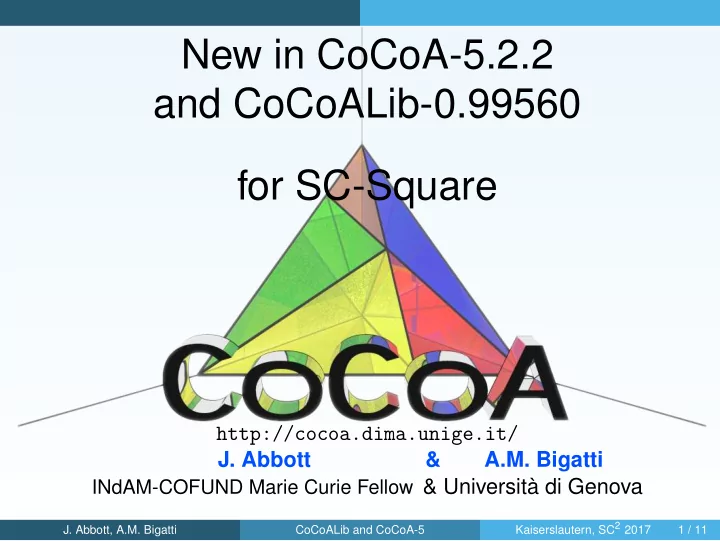

New in CoCoA-5.2.2 and CoCoALib-0.99560 for SC-Square http://cocoa.dima.unige.it/ J. Abbott & A.M. Bigatti INdAM-COFUND Marie Curie Fellow & Università di Genova Kaiserslautern, SC 2 2017 J. Abbott, A.M. Bigatti CoCoALib and CoCoA-5 1 / 11
Overview The CoCoA project began in 1987 under the lead of Prof. L. Robbiano. The aim was to create a mathematician-friendly software laboratory for studying Computational Commutative Algebra (multivariate polynomials). Available as open-source software: 2 main components CoCoALib — C++ library CoCoA-5 — interactive system Main new features in CoCoALib-0.99560 and CoCoA-5.2.2 interrupt handling and timeout capability global verbose option (user-settable verbosity level) minimal polynomials in quotients by 0-dim ideals − → radical, primary decomposition, tests for maximal or primary efficient hypersurface implicitization improved Gröbner fan operations (needs GFanLib ) prototype interface with MathSAT Kaiserslautern, SC 2 2017 J. Abbott, A.M. Bigatti CoCoALib and CoCoA-5 2 / 11
Interrupt mechanism Interrupt Mechanism: example C++ program void LongComputation() { ... for (int i=1; i < n; ++i) // MAIN LOOP { CheckForInterrupt("LongComputation"); // arg gives context info ... } ... } void program() { ... SignalWatcher MonitorSIGINT(SIGINT); // RAII object try { LongComputation(); } catch (const InterruptedBySignal& intr) { PrintInFrame(cout, intr); /*handle the interrupt*/ } } Kaiserslautern, SC 2 2017 J. Abbott, A.M. Bigatti CoCoALib and CoCoA-5 3 / 11
Timeout mechanism Timeout Mechanism: example C++ program // New fn to add "timeout" feature to existing fn: vector<RingElem> RGBasisTimeout(const ideal& I, double Tmax) { CpuTimeLimit timeout(Tmax); return ReducedGBasis(I); // <-- this fn must call CheckForInterrupt } void program() { GlobalManager CoCoAFoundations; ... ideal I = ideal(f1,f2,f3); // Next line will throw InterruptedByTimeout if timeout occurs: vector<RingElem> RGB = RGBasisTimeout(I, 3.0); // max 3.0 seconds } Kaiserslautern, SC 2 2017 J. Abbott, A.M. Bigatti CoCoALib and CoCoA-5 4 / 11
Minimal Polynomial Computation Timings for MinPolyQuot 0-dim ideal (gen. by dense random polys) dense random element in span of “quotient basis” in ring Q [ x , y , z ] ; random coeffs are in range − 9 . . . 9 Deg Time Eliminate 3 1.4 45 4 28 14000 + 5 295 — 6 2050 — 7 11600 — Time is worst of 5 trials Kaiserslautern, SC 2 2017 J. Abbott, A.M. Bigatti CoCoALib and CoCoA-5 5 / 11
Minimal Polynomial Computation Timings for PrimaryDecomposition Randomly generated zero-dimensional ideals in Q [ x , y , z ] Favourable case � 29 x 3 y 3 + 94 yz 5 + 99 x 4 , − 36 y 3 z 3 − 67 z 6 − 3 x 4 y , 19 x 3 y 3 + 97 x 2 z 2 − 85 y 2 � CoCoA took 5.6s Singular took 1600s Unfavourable case �− 11 x 5 − 10 x 4 y + 12 y 3 z , − 14 z 4 + 15 y 3 + 13 yz , 9 xz 4 + x 3 y + 2 y 3 z � CoCoA took 45s Singular took 3.3s Kaiserslautern, SC 2 2017 J. Abbott, A.M. Bigatti CoCoALib and CoCoA-5 6 / 11
Web site Web site: http://cocoa.dima.unige.it/ Interim downloads: CoCoALib v. 0.99555 (August 2017) CoCoA v. 5.2.1 (August 2017) Imminent stable downloads: CoCoALib v. 0.99560 (expected September 2017) CoCoA v. 5.2.2 (expected September 2017) Also... redmine (bug/feature tracker), & other useful bits and bobs. Kaiserslautern, SC 2 2017 J. Abbott, A.M. Bigatti CoCoALib and CoCoA-5 7 / 11
CoCoA and MathSAT CoCoA and MathSAT Two actors of the SC 2 project: MathSAT : SMT solver (Trento) CoCoALib / CoCoA-5 : Computer Algebra System (Genova) One SC 2 deliverable: prototype of communication between them MathSAT using CoCoALib ’s RingTwinFloat arithmetic 1 (instead of arbitrary precision rationals, GMP mpq ) MathSAT using CoCoALib for systems of polynomial inequalities 2 (future! hopefully) enabling CoCoALib to call some of MathSAT ’s functions 3 using CoCoA-5 as a handy interface for MathSAT 4 (through CoCoALib) Kaiserslautern, SC 2 2017 J. Abbott, A.M. Bigatti CoCoALib and CoCoA-5 8 / 11
CoCoA and MathSAT C++ program (3) CoCoAlib calling MathSAT: C++ program excerpt ring P = NewPolyRing(QQ, symbols("x,y")); MathSAT::env E; matrix M = NewDenseMat(QQ, 2, 3); // (2x3 matrix) SetEntry(M,0,0, 3); SetEntry(M,0,1, 1); SetEntry(M,0,2, -2); SetEntry(M,1,0, 1); SetEntry(M,1,1, -1); SetEntry(M,1,2, 0); MathSAT::AddLeq0(E, M); // 3*x -y -2 <= 0 // x -y <= 0 M = NewDenseMat(QQ, 1, 3); SetEntry(M,0,0, 1); // (1x3 matrix) MathSAT::AddNeq0(E, M); // x != 0 // polynomial syntax: RingElem x(P,"x"), y(P,"y"); MathSAT::AddLeq0(E, x -9); // x -9 <= 0 MathSAT::AddEq0(E, x -y); // x -y = 0 MathSAT::AddLt0(E, 2*x-1); // 2*x -1 < 0 cout << "A solution is " << MathSAT::LinSolve(E) << endl; //-> 1/4, 1/4 Kaiserslautern, SC 2 2017 J. Abbott, A.M. Bigatti CoCoALib and CoCoA-5 9 / 11
CoCoA and MathSAT Interactive call (4) CoCoA-5 calling MathSAT: interactive call We represent a system as a record of matrices (first prototype): system := record[leq0 := matrix([[1,2,3, 4], // x +2*y +3*z +4 <= 0 [9,8,7, 0]]),// 9*x +8*y +7*z <= 0 neq0 := matrix([[1,0,0, 0]]) // x <> 0 ]; sol := MSatLinSolve(system); sol; // gives [[1], [4/5], [-11/5]] // verify: sol1 := ConcatVer(sol, matrix([[1]])); //--> [[1], [4/5], [-11/5], [1]] system.leq0 * sol1; //--> 0, 0 <= 0 system.neq0 * sol1; //--> 1 <> 0 Kaiserslautern, SC 2 2017 J. Abbott, A.M. Bigatti CoCoALib and CoCoA-5 10 / 11
CoCoA and MathSAT Interactive call Continuation: // solution was [[1], [4/5], [-11/5]] // now we add new contraints: system.eq0 := RowMat([1,1,0, 4]); // x +y +4 = 0 system.lt0 := RowMat([0,1,0, 0]); // y < 0 sol := MSatLinSolve(system); sol; // gives [[-2], [-2], [-2/7]]) // verify: sol1 := ConcatVer(sol, RowMat([1])); //--> [[-2], [-2], [-2/7], [1]] system.leq0 * sol1; //--> -20/7, -36 <= 0 system.neq0 * sol1; //--> -2 <> 0 system.eq0 * sol1; //--> 0 = 0 system.lt0 * sol1; //--> -2 < 0 Kaiserslautern, SC 2 2017 J. Abbott, A.M. Bigatti CoCoALib and CoCoA-5 11 / 11
Recommend
More recommend